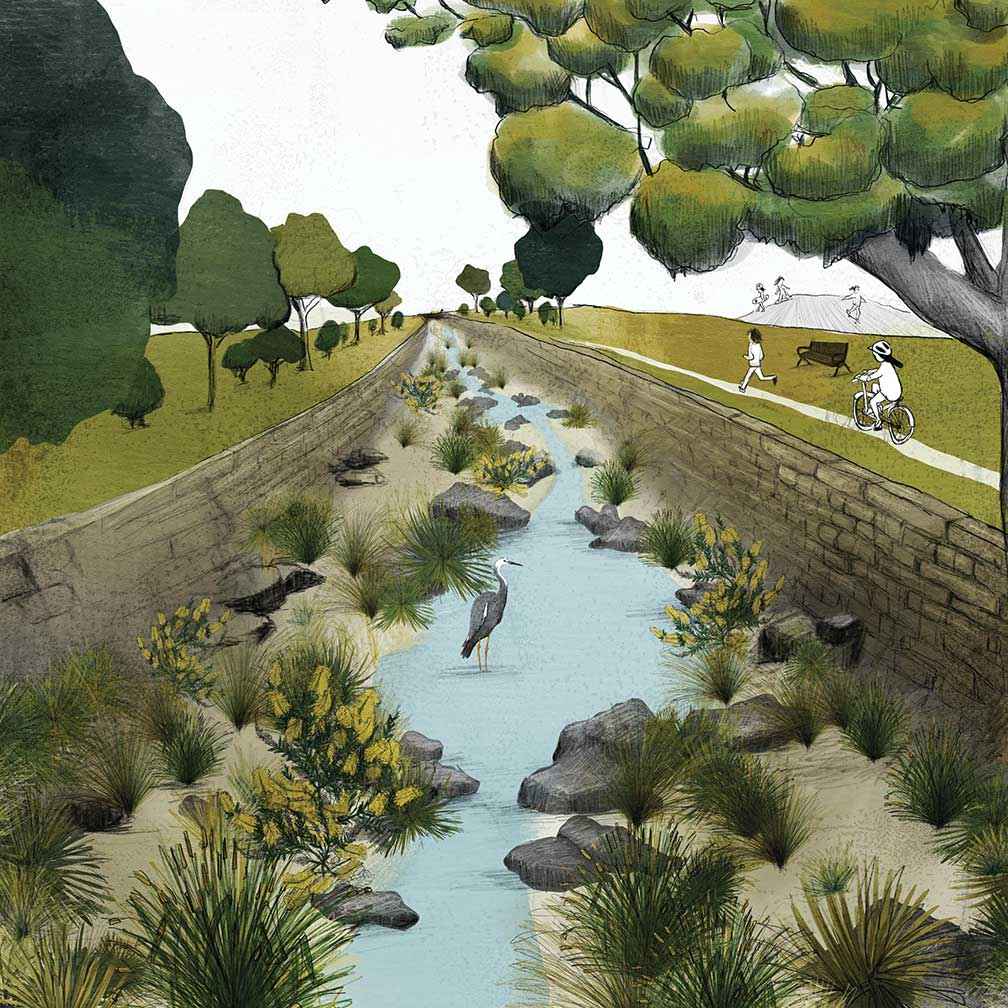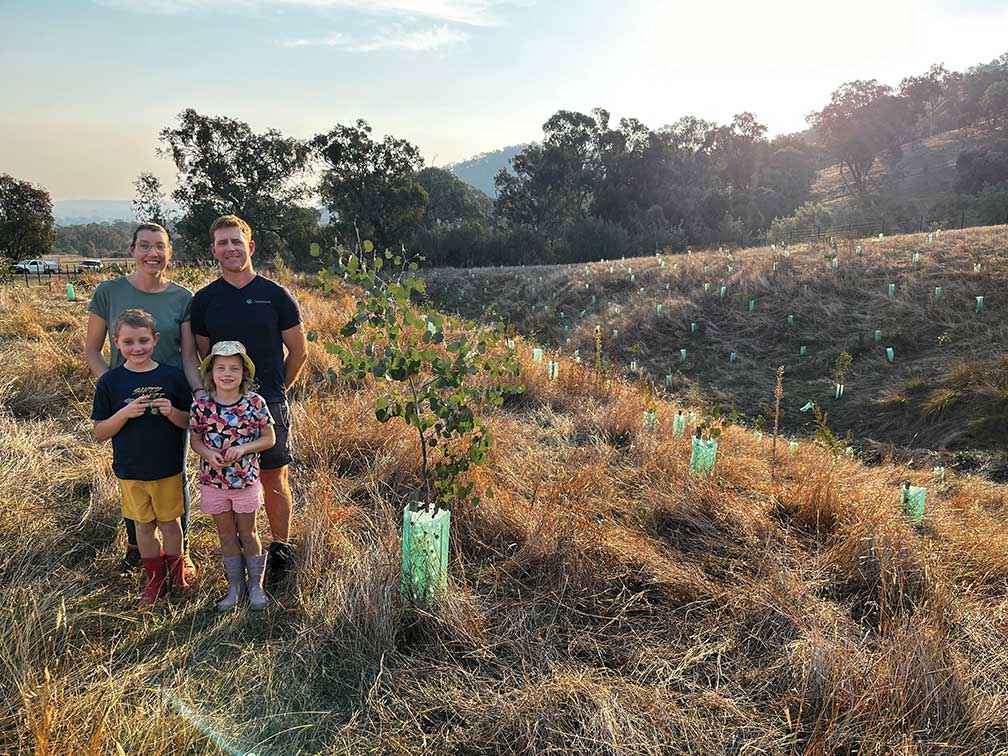Victorian Landcare Magazine - Spring 2024, Issue 88
When the 2020 COVID crisis hit and many Melburnians packed up and fled to Victoria’s regions, there was little sense of what the future might hold. Would they be welcomed by the local community? Would they stay once lockdowns lifted? Would the great regional migration actually stick?
More than three years on and the answer to each of the above all appear to be: Yes. And as the seachangers and treechangers began integrating into their growing communities, it became clear that they could be harnessed for the greater good of the environment.
Sophie Small, Landcare Facilitator of the Bellarine Landcare Group (BLG), said the Bellarine Peninsula had experienced something of a post-pandemic population explosion and that many of the new
arrivals had come to realise the mental health benefits of connecting with nature – something they’d missed during the
metropolitan lockdowns.
And this, according to Sophie, is where Landcare can step in.
“All of a sudden, we have this groundswell of people wanting to engage with nature. They want to be outdoors, they want to connect with each other and the environment, and they want to contribute to their new community.
“So, we tried to come up with some new activities which we thought would appeal to the new people from Melbourne. First, we held an art show, which was a great success.”
The group soon found that many newcomers were keen to learn more about indigenous plants.
“We have this fantastic indigenous plant nursery, which is a partnership with Bellarine Secondary College. Together we propagate around 50,000 plants a year for local revegetation, and we have about 40 volunteers doing this with us. Promoting the nursery has really brought the newcomers to us,” Sophie said.
One of the BLG’s newer volunteers is Fern Smith, who arrived during the pandemic. Fern is now busy each Monday in the nursery’s propagation room growing seedlings and feeling a sense of community connection.
“What I like about Landcare is you are part of a bigger program. You know that there’s a lot of people out there planting local plants in the local area, and that really makes my heart sing. And knowing that I’m helping just a little bit in that process is great,” Fern said.
BLG received $33,039 funding for two Project Grants through the 2023 Victorian Landcare Grants.
Sophie Small is the Landcare Facilitator for Bellarine Landcare Group. Her position is funded through the Government’s Victorian Landcare Facilitator Program.
For more information email sophie@bcn.org.au or go to bellarinelandcare.org.au

Above: A concept image of a revitalised Forest Creek.
Castlemaine Landcare Group (CLG) received a Victorian Landcare Grant in 2021 for a project to revitalise a section of Forest Creek. The Forest Creek Revitalisation Project was the next step in work undertaken in 2018 by Professor Ian Rutherfurd, from the University of Melbourne, who developed an options paper for the rejuvenation of the creek.
The Victorian Landcare Grant assisted the group with developing a scoping study with a concept design to rewild and rejuvenate 600 metres of the most urban section of Forest Creek, which flows through Castlemaine. The site is subject to stormwater runoff, litter, a dominance of common reed in the channel and other urban weeds.
Despite its urban nature the creek supports indigenous, heritage, social, recreational and natural values. The project aims to highlight and improve these values.
The Forest Creek Revitalisation Project is a partnership project between CLG and Djaara (Dja Dja Wurrung Clans Aboriginal Corporation), Mount Alexander Shire Council, North Central CMA, DEECA, and Friends of Campbells Creek.
The Victorian Landcare Grant enabled the CLG’s Forest Creek Revitalisation Project Implementation Group to engage a consultant to help develop publicity materials, undertake a mail-out to key stakeholders, organisations and local businesses and run an online survey. The group also held four information stalls to engage with the local community at the local Farmers’ Market and at other locations to gather the views of residents and visitors.
There was strong endorsement for the plan to improve creek health and biodiversity, along with additional values such as improved accessibility and recognition of cultural heritage, both First Nations and post-settlement.
Our project partner, Djaara, convened a Kapa Gatjin group of Dja Dja Wurrung Elders and Traditional Owner representatives to provide input into the project, including the design phase. Kapa Gatjin (to know water) provides a Traditional Owner cultural perspective to water related matters and included undertaking an Aboriginal Waterway Assessment.
Support through the Victorian Landcare Grant has helped the Implementation Group to gain further project funds through a Victorian Government Integrated Water Management Grant.
According to project co-convenor Jon Leevers, on-ground works will commence once detailed designs are finalised and are due to start late spring, to early summer 2024, depending on the weather.
“When the project is complete it will provide aquatic and riparian habitats and a recreational area that the community can utilise and be proud of as an urban feature in the township,” Jon said.
Kaye Swanton and Jon Leevers are the co-convenors of the Forest Creek Revitalisation Project Implementation Group.
For more information email castlemainelandcaregroupinc@gmail.com

Above: Travis Edmondson and his family at the revegetated erosion gully on their property at Barnawartha North.
Indigo Creek Landcare Group (ICLG) received a Victorian Landcare Grant in 2022 for extensive revegetation works to increase habitat and biodiversity in the Indigo Creek catchment in northeast Victoria.
The project aimed to build community capacity for Landcare projects by supporting the many landholders still recovering from the December 2015 fires that burnt around 7000 hectares of the local landscape. In addition to addressing the impacts of fire, the on-ground works aimed to remedy the impacts of historical land clearing resulting in the loss of older remnant trees and bushland and fragmentation of vegetation, as well as soil erosion, increased urbanisation and climate change.
Throughout winter of 2022, 12 ICLG members undertook revegetation projects on their properties, planting a total of 2270 plants. These landholders planted to achieve various objectives unique to their properties and their needs, specifically to increase biodiversity, address erosion and provide shelter for stock by planting out gullies, establishing shelter belts and linking vegetation corridors. ICLG also provided plants to Middle Indigo Primary School and Barnawartha Primary School.
Landholders took on the responsibility of completing their revegetation projects, including site preparation and planting. Some landholders utilised the assistance available through the Landmate program. A member of the Barnawartha school community organised an in-school working bee in September 2022, where students planted out part of the school grounds. More than 70 volunteers assisted with the on-ground works component of the project.
The group was challenged by a lack of available tubestock in the region, so the grant agreement was modified to include the supply and installation of 40 nest boxes to complement the revegetation efforts. It is hoped that these nest boxes will provide much needed habitat for turquoise parrots, sugar gliders, squirrel gliders and brush-tailed phascogales.
The group were also able to deliver three events as part of this project. Successful community events on building habitat and biodiversity through revegetation and climate-smart farm planning were well received. The group also ran a school incursion on reptiles with Barnawartha Primary School and Middle Indigo Primary School.
Travis Edmondson and family, landholders from Barnawartha North, received more than 600 plants and corflute tree guards as part of the project. With help from the Landmate Program they planted out a large erosion gully with the view to increasing soil stability and reducing run off, improving water quality, building habitat by establishing a wildlife corridor, increasing biodiversity, providing shade and shelter for stock and providing food sources for pollinators.
“We have already seen some benefits of our revegetation project planted out in July 2022, with many of the plants now over 1.5 metres tall and a huge increase in the number of native insects around. We were also fortunate to receive five nest boxes which were installed in our remnant grassy woodlands near our revegetation site. We have already seen signs of activity in these nest boxes,” Travis said.
The project was co-funded through the Bush for Birds Program. Delivered in partnership between the Northeast CMA and Trust for Nature, Bush for Birds supports landholders in north east Victoria to create and improve habitat for regent honeyeaters and swift parrots, two nationally endangered birds.
Richard Dalkin is North East CMA’s Regional Landcare Coordinator.
For more information email richard.dalkin@necma.vic.gov.au